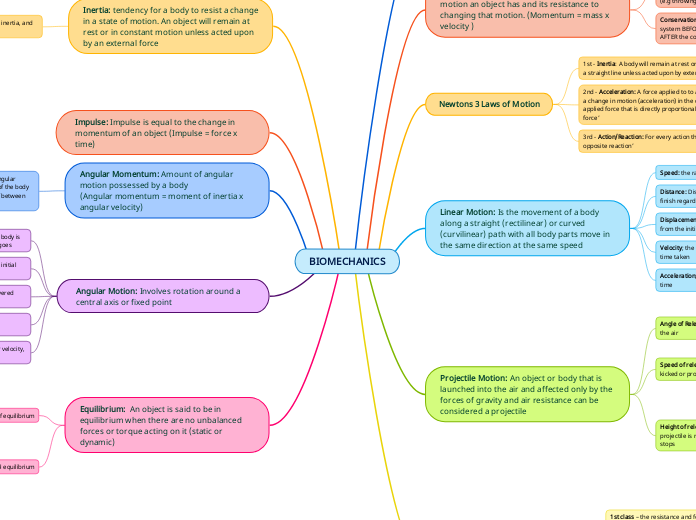BIOMECHANICS
Force: push or pull (FORCE = MASS x ACCELERATION)
Air/Water
Friction
Gravitational
Weight
Momentum: Is a measure of the amount of motion an object has and its resistance to changing that motion. (Momentum = mass x velocity )
Summation of Momentum: The sequential and coordinated movement of each body part to produce maximum velocity (e.g throwing a ball)
Conservation of Momentum: The total momentum of the system BEFORE the collision is equal to the total momentum AFTER the collision (e.g hitting a puck in hockey)
Newtons 3 Laws of Motion
1st - Inertia: A body will remain at rest or in uniform motion in a straight line unless acted upon by external force’
2nd - Acceleration: A force applied to to an object will produce a change in motion (acceleration) in the direction of the applied force that is directly proportional to the size of the force’
3rd - Action/Reaction: For every action there is an equal and opposite reaction’
Linear Motion: Is the movement of a body along a straight (rectilinear) or curved (curvilinear) path with all body parts move in the same direction at the same speed
Speed: the ratio of the distance covered to the time taken
Distance: Distance; measures a path travelled from start to finish regardless of direction
Displacement: Displacement; change in position. How far it is from the initial position to the final position.
Velocity; the ratio of displacement, or change in position, to the time taken
Acceleration; refers to a change in velocity in a given period of time
Projectile Motion: An object or body that is launched into the air and affected only by the forces of gravity and air resistance can be considered a projectile
Angle of Release: The angle at which an object is projected into the air
1.Vertical trajectory – straight up and back down (e.g vertical jump)
2.Oblique trajectory – occurs when he angle of projection is between 0 and 90 degrees
3.Horizontal trajectory – an object projected at 0 degrees
Speed of release: The speed at which an object is thrown, kicked or propelled in the air
Height of release: The difference between the height that a projectile is released from and the height at which it lands or stops
When the height of release is zero, the projectile height equals the landing height, and the optimal angle of release is 45 degrees
When the release height is greater than 0, the projectile height is greater then the landing height, and the optimal angle of release is less than 45 degrees
When the release height is less then 0, the projectile height is greater then the landing height, and the optimal angle of release is greater than 45 degrees
Levers: Axis, Resistance and Force
1st class – the resistance and force are on either side of the axis
Mechanical Advantage <1, =1and >1: BALANCE, SPEED, RANGE OF MOTION AND FORCE
Overhead throw, head tilt
2nd class – the resistance is between the force and the axis
Always >1: LARGE RESISTANCE CAN BE MOVED
Wheelbarrow, calf raises
3rd class – the force is between the resistance and the axis
Always <1: SPEED AND RANGE OF MOTION
Bicep curl, hitting a baseball
Inertia: tendency for a body to resist a change in a state of motion. An object will remain at rest or in constant motion unless acted upon by an external force
The greater the mass of an object, the greater its inertia, and the greater the force needed to change its state
Impulse: Impulse is equal to the change in momentum of an object (Impulse = force x time)
Angular Momentum: Amount of angular motion possessed by a body
(Angular momentum = moment of inertia x angular velocity)
Conservation of angular Momentum: If the total angular momentum of a body is conserved, and the mass of the body cannot be changed, then there must be a trade-off between angular velocity and moment of inertia
Angular Motion: Involves rotation around a central axis or fixed point
Angular Distance; the distance covered by a rotating body is the sum of all of the angular changes the body undergoes
Angular Displacement; is the difference between the initial and the final angular position of an object;
Angular Speed; is defined as the angular distance covered divided by the time taken to complete the motion
Angular Velocity; the rate of change of the angular displacement of body over time
Angular acceleration; is the rate of change of angular velocity, or how quickly a body changes its angular position
Equilibrium: An object is said to be in equilibrium when there are no unbalanced forces or torque acting on it (static or dynamic)
Stability: the resistance to the disruption of equilibrium
Centre of gravity
Line of gravity:
Body Mass:
Friction:
Balance: The ability to control equilibrium
